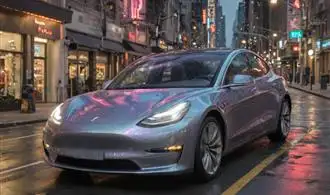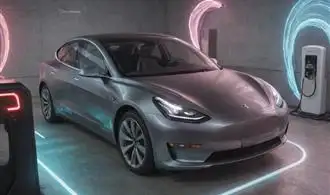
Range Comparison
When it comes to electric vehicles, range is a crucial factor that can make or break a purchase decision. The Tesla Model 3 and the Nissan Leaf are two popular models, but their range capabilities differ significantly. The Model 3 boasts an impressive range of up to 322 miles on a single charge, while the Leaf has a more limited range of up to 226 miles.
The extended range of the Tesla Model 3 is achieved through its advanced battery technology and efficient powertrain design. The car's lithium-ion battery packs are built with high energy density, allowing for a larger storage capacity without significantly increasing the vehicle's weight or size. Furthermore, the Model 3's regenerative braking system helps to recapture energy during deceleration, further extending the car's range.
In contrast, the Nissan Leaf's range is constrained by its smaller battery pack and less advanced powertrain technology. While the Leaf has made significant strides in improving its range over the years, it still lags behind the Model 3 in terms of overall driving distance on a single charge.
The practical implications of this range difference are significant. Owners of the Tesla Model 3 can enjoy longer road trips and reduced range anxiety, as they can confidently travel between charging stations without worrying about running out of power. This expanded range also allows for more flexibility in daily commuting and running errands, as the Model 3 can cover a larger area on a single charge.
Furthermore, the Tesla Model 3's ability to charge rapidly at the company's extensive Supercharger network further enhances its range capabilities. The car can add up to 175 miles of range in just 15 minutes, making it much more convenient for long-distance travel than the Leaf, which has a slower charging time.
Acceleration Showdown
The Tesla Model 3 and the Nissan Leaf are both electric vehicles, but their performance in the acceleration department is vastly different. The Tesla Model 3 boasts impressive acceleration capabilities that easily outshine the Nissan Leaf, making it a more thrilling and dynamic driving experience.
At the heart of the Tesla Model 3's acceleration prowess is its electric powertrain. The vehicle's instant torque delivery, combined with its efficient electric motor, allows the Model 3 to sprint from 0 to 60 mph in as little as 3.1 seconds, depending on the specific configuration. This lightning-fast acceleration is a testament to Tesla's engineering prowess and the company's commitment to delivering a truly exhilarating driving experience.
In contrast, the Nissan Leaf, while a capable and efficient electric vehicle, falls short in the acceleration department. With a 0 to 60 mph time of around 7.5 seconds, the Leaf feels sluggish and uninspiring when compared to the Tesla Model 3. The Leaf's acceleration is adequate for city driving and commuting, but it lacks the thrilling responsiveness and sheer power that the Model 3 delivers.
The Tesla Model 3's acceleration advantage is not just about raw numbers; it's about the driving experience. The instant torque and seamless power delivery make the Model 3 feel agile and responsive, allowing drivers to effortlessly merge onto highways, pass slower vehicles, and navigate tight turns with confidence. This level of performance is simply unmatched by the Nissan Leaf, which can feel lethargic and underpowered in comparison.
Moreover, the Tesla Model 3's acceleration is not just limited to the base model. The performance-oriented variants, such as the Model 3 Performance, take the acceleration experience to an even higher level. These models can accelerate from 0 to 60 mph in as little as 3.1 seconds, providing supercar-like performance in a practical and efficient electric sedan.
Charging Infrastructure
The Tesla Model 3's charging infrastructure sets it apart from competitors like the Nissan Leaf. Tesla's Supercharger network, a network of high-speed charging stations exclusively for Tesla vehicles, provides unparalleled convenience and accessibility for Model 3 owners. With over 25,000 Superchargers worldwide, Tesla's charging network is the largest and most extensive in the industry, allowing Model 3 drivers to charge their vehicles quickly and efficiently during long-distance travels.
The Supercharger network is a game-changer for electric vehicle ownership. Unlike the Nissan Leaf, which relies on the public charging infrastructure, the Model 3 can tap into Tesla's dedicated charging stations, which are strategically placed along major highways and in high-traffic areas. This means Model 3 owners can charge their vehicles quickly and easily, with charging times as low as 15 minutes for a significant boost in range.
In addition to the Supercharger network, the Tesla Model 3 also benefits from a robust home charging solution. The vehicle comes equipped with a Level 2 charger that can be installed in the owner's home, allowing for convenient overnight charging and ensuring the vehicle is ready for the next day's commute. This level of charging convenience and reliability is a significant advantage over the Nissan Leaf, which may require more planning and effort to ensure adequate charging during daily use.
Furthermore, the Tesla Model 3's charging infrastructure is designed with the future in mind. The vehicle's software is regularly updated, allowing for seamless integration with the latest charging technologies and improvements to the Supercharger network. This ensures that Model 3 owners can take advantage of the latest advancements in electric vehicle charging, providing a level of futureproofing that the Nissan Leaf may not offer.
Autonomous Driving Features
When it comes to the Tesla Model 3 and Nissan Leaf, the autonomous driving features are a key differentiating factor. The Tesla Model 3 boasts a suite of advanced driver-assistance technologies that set it apart from its Nissan counterpart.
The Tesla Model 3 comes equipped with Autopilot, a comprehensive system that combines adaptive cruise control, lane-keeping assist, and automatic lane change capabilities. This system uses a complex array of sensors, including cameras, radar, and ultrasonic sensors, to monitor the surrounding environment and make real-time decisions to keep the vehicle safely within its lane and at a safe distance from other vehicles.
One of the standout features of Autopilot is its ability to perform lane changes with the simple tap of a turn signal. The system seamlessly navigates the vehicle into the adjacent lane, providing a smooth and convenient driving experience. Additionally, Autopilot can handle more complex situations, such as navigating highway interchanges and adapting to changing road conditions.
In contrast, the Nissan Leaf's autonomous driving features are more limited. While it offers adaptive cruise control and lane-keeping assist, the system is not as advanced as Autopilot. The Leaf's driver-assistance technologies are primarily focused on providing basic safety features, rather than the more comprehensive and versatile capabilities of the Tesla Model 3.
Moreover, the Tesla Model 3 is equipped with a feature called "Full Self-Driving Capability," which is an optional upgrade that takes the autonomous driving experience to the next level. This system, when activated, allows the vehicle to navigate city streets, recognize traffic lights and stop signs, and even perform unassisted parking maneuvers.
The Full Self-Driving Capability is continuously being refined and updated through over-the-air software updates, ensuring that the system remains at the forefront of autonomous driving technology. In contrast, the Nissan Leaf does not offer a comparable advanced self-driving system, limiting its capabilities in this regard.
Interior Comfort and Design
The interior of the Tesla Model 3 is a testament to the brand's commitment to innovative design and user experience. From the moment you step into the cabin, you're greeted by a sleek and minimalist aesthetic that seamlessly blends form and function. The Model 3's interior is not just visually stunning, but it also offers unparalleled comfort and a level of refinement that sets it apart from its competitors, including the Nissan Leaf.
One of the standout features of the Model 3's interior is its expansive and ergonomically designed seats. The front seats provide ample support and adjustability, ensuring a comfortable driving position for both the driver and the passenger. The rear seats are equally impressive, offering generous legroom and headroom, making the Model 3 a comfortable choice for longer journeys or for accommodating taller passengers.
The interior materials used in the Tesla Model 3 are of exceptional quality, with a focus on premium and sustainable materials. The use of soft-touch surfaces, high-quality plastics, and sleek metal accents create a luxurious ambiance that belies the car's relatively affordable price point. The attention to detail is evident in the seamless integration of the various controls and interfaces, providing a cohesive and intuitive driving experience.
The Model 3's centerpiece is its large, 15-inch touchscreen display, which serves as the main control hub for the vehicle's various functions. This intuitive and responsive interface allows the driver to easily access and manage a wide range of features, from the climate control system to the advanced infotainment and connectivity options. The minimalist dashboard design, devoid of traditional buttons and knobs, contributes to the overall clean and modern aesthetic of the interior.
















